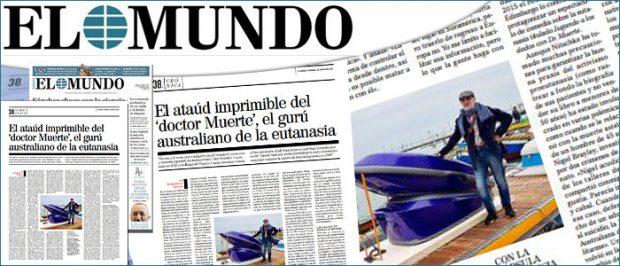The Printable Coffin of ‘Doctor Death’, the Australian Guru of Euthanasia
“It’s not for sale, but anyone can print it out at home and assemble it by following the instructions,” says Nitschke.
He presented it in 2019 at the Venice Biennale and several people, he says, have been interested from Spain in his futuristic sarcophagus to die.
“I was captivated by the civil disobedience and social activism that surrounded the death of Ramón Sampedro in 1998”
In the summer of 1996, Philip Nitschke became the first physician in the world to administer a lethal injection in the first ever case of assisted legal euthanasia.
Only four people from the Australian state of Northem Territory were eligible for the new law, which was repealed nine months later. “Against public opinion, the Australian Medical Association and the Church, it was my turn to make the law work,” confesses the 73-year-old activist.
“To do this, I invented the Deliverance machine, a software connected to the patient’s arm that allows him to self-administer lethal drugs into a vein using a computer-assisted procedure.”
That artifact is now on display in the London Science Museum as an engineering milestone in the fight for the right to a dignified death.
But it is not the only one.
Nitschke has spent the last three years creating Sarco (the printable coffin of Doctor Death), a revolutionary 3D printable coffin that provides a quick, painless and peaceful death.
“It is designed to lower the oxygen and CO2 levels inside the capsule, which ends up producing hypoxia, loss of consciousness and, ultimately, death,” explains its inventor.
“The sensation is similar to that generated by a sudden depressurization in an airplane: placid sleep, vertigo, disorientation and even euphoria.”
The printable coffin of Doctor Death, which was presented at the 2019 Venice Biennale, cost €300,000, part of which is being used to develop artificial intelligence software that analyzes the mental capacities of the occupants.
“It is not for sale, but anyone can print it at home and assemble it afterwards. You will be able to follow the instructions in the .
If all goes well, it will be used in Switzerland for the first time at the end of this year.”
Sarco was conceived as an “ethically and aesthetically effective alternative” to the suicide kits (such as the nitrogen bag) promoted by Exit International, the non-profit organization that Nitschke founded in 1997.
Because the machine is portable, it allows for the planning one’s death in a desired place: in the mountains, next to a lake or on a paradisiacal beach.
You can also choose a dark or transparent view.
The mission of this “object of artistic beauty”, exhibited at the Cube Design Museum in Limburg in the Netherlands in 2020 and at the Museum for Sepulkralkultur in Kassel Germany in 2021, is twofold: to minimize the agony (the process lasts five minutes) and to demedicalize the death process.
Many people found the practice of the plastic bag with gas repulsive.
Since Sarco does not require controlled drugs, it eliminates the need for a psychiatric evaluation and can be used in some countries without medical involvement.
And he adds: “The only way to control the coffin is from the inside, so it is not possible to kill someone with it.”
In his early days as a euthanasia guru, Nitschke sold nitrogen cylinders so that people could self-deliver, and he also helped them get Nembutal.
“Actually, this was not exactly the case.”
In the year 2000 I founded with a friend a company of accessories for brewing beer, one of my passions.
We do not commit any illegality, since nitrogen dispensing cylinders have multiple applications.
As for Nembutal, in my book, The Peaceful Pill Handbook (La Pildora Apacible – in Spanish), I offer detailed instructions on how to obtain it in countries such as Mexico and Peru, or via the internet.
The purchase of this drug without a prescription could be legal in South America, but not bringing it back to Europe.
I limit myself to providing that information, but what people do with it is their business.
The Nickname Dr Death
These practices at the limit of legality earned him the nickname of Doctor Death.
“At first it bothered me that they called me that, but then I appropriated it as a sign of identity.”
So much so that in 2015 at the Edinburgh Fringe Festival he had a comedy show about euthanasia titled ‘Dicing Dice with Dr. Death’.
Although Nitschke has taken many precautions to ensure the good practice of pro-euthanasia activism (such as thoroughly tracking of his patients and not selling his book to those under 50 years of age) he has been involved in various controversies, such as when he was linked to the assisted death of a 45-year-old man, Nigel Brayley, who was being investigated for two murder crimes.
“Nigel attended one of the Exit workshops and shared his anguish with me. He seemed knowledgeable and thorough.
When, in the wake of that case, I defended the right of a rational adult to suicide, the Australian Medical Board decided to disqualify me.
A court returned his medical license. The Medical Board demanded he remove his name from the cover of his book.
“That seemed unacceptable to me. So I burned my license and fled Australia in search of a more hospitable political environment.”
Since 2015 he lives in Ámsterdam.
“Here the debate goes beyond assisted death for sick people to more and encompasses what is known as a complete life”.
Healthy old people who do not want to continue in this world any more.
The digital version of The Peaceful Pill Handbook, the first volume was banned by the Australian authorities, the only Australian book to be banned in the last 50 years, is updated every month.
“We have recently included information on the new anti-covid helmets as an alternative to gas bags and the latest data on deaths from ‘Middel X’, a deadly powder without a prescription distributed among 20,000 members of a Dutch cooperative.
The Keys of Ramon Sanpedro
Nitschke does not hide the emotion he experienced in March this year when he learned that Spain was joining the exclusive club of the five countries (together with the Netherlands, Belgium, Luxembourg and Canada) that regulate Euthanasia.
“I was totally captivated by the social activism and civil disobedience that surrounded the death of Ramón Sampedro in 1998″, he tells me.
“In fact, Exit copied the strategy of the keys to his apartment distributed among several friends in the famous case of Nancy Crick in Australia.”
Doctor Death says that several people have been interested in Spain for its futuristic sarcophagus for euthanasia.
“With a bit of luck, Sarco will contribute to improve the conditions of people who, in a rational, free and informed way, decide to end their life.”


